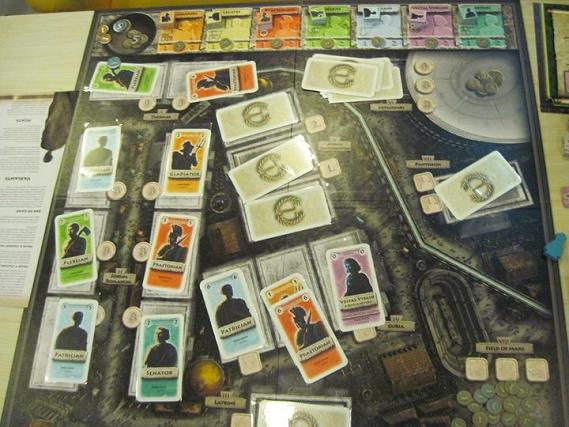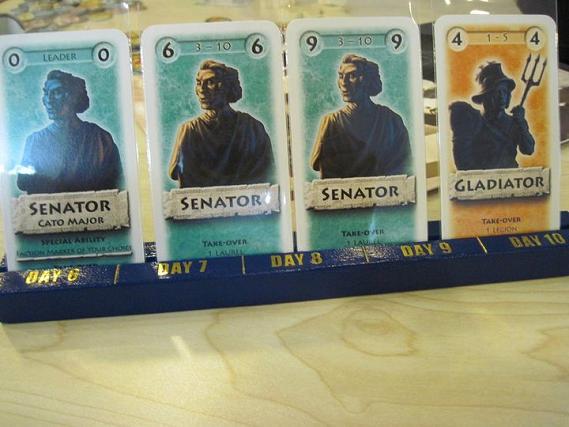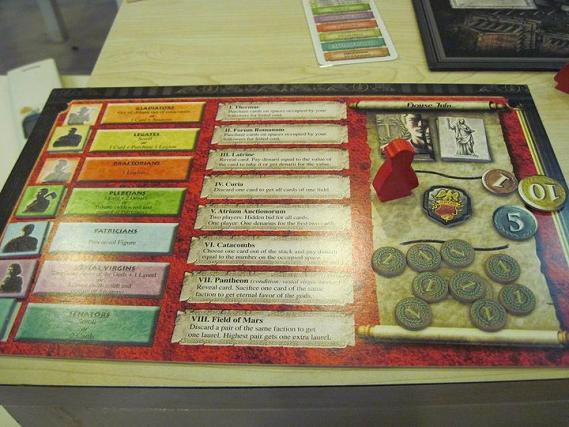
Ever since we first played Die Macher, it’s been a game that my wife and I have thought about often. So when I learned that its designer, Karl-Heinz Schmiel, also has a Roman-themed game that’s published in English by Fantasy Flight to boot, I was very much interested. It turns out that Sean does own a copy but has never played it. In fact, he hadn’t read the rules either, so I had to read them and teach him. He did warn us that I probably shouldn’t expect too much as Schmiel is also known for designing some dud games and Die Macher should be considered the outlier.
Tribune is set in some indeterminate point in time in ancient Rome and the players embody the various aristocratic families vying for dominance over the republic. The actual victory conditions vary from game to game as you’re supposed to select them from a set of cards. These cards list various conditions, such as possessing a Tribune tile, having a certain number of Laurel Wreaths, controlling a certain number of Legions etc. and depending on the number of players, you may need to meet only a subset of the listed conditions to win. You collect all this stuff by taking and keeping control of the various factions in Rome and that’s what the game is all about.
At its heart, Tribune is a card drafting game as the players compete with each other to collect the cards that become available on the board each turn. These cards are then played to try to seize control of the various factions. The card drafting part uses a worker placement mechanic as each player has a number of meeples, depending on the number of players in the game, that they take turns to place on the board. This is quite similar to Caylus especially as nothing happens when the followers are first placed and you need to wait until the next phase to resolve each area of the board with followers on them in a fixed sequence.

The board represents the different locations in Rome where the cards can be obtained. All of the open spaces are always refilled with new cards at the beginning of each turn, so cards that were left from the end of the previous turn are all discarded. Each of these locations, called regions, have suitable thematic names and have different rules. So the Thermae, representing the public baths of Rome, have two spaces for cards to be placed face up on it. Each space has a corresponding space for a follower token. During the region evaluation phase, the player with a meeple on one of these spaces simply pays 1 denarii, the currency used in the game, and puts the associated card into his hand.
Some of the card spaces on the board are darker in color and cards are played face down on them. One example of this is the Atrium Auctionorum, or auction house. This region has three spaces for cards and two spaces for followers. When a player first puts a meeple on it, he chooses any of the two cards to turn face up. If no one else puts a meeple in the second space by the time it is resolved, the player simply pays 1 denarii and takes both of the face up cards. If there is another competing player, then the third card is turned face up as well and the two players then start a blind bid. They each hold the number of denarii they’re willing to pay in a fist and open them at the same time. The winner pays the amount he bid to the loser and takes all three cards.
Since each of the eight regions on the board have different rules, all this takes quite a bit of explanation but in practice, it’s all quite clearly laid out and easy to remember. In addition to these regions, players can also place followers in the coin bowl to collect denarii (7 for the first player to put a meeple, 5 for all subsequent followers) and in the faction spaces to try to gain control of the associated faction. Contests are pretty simple. If you’re the first player to try to gain control of a given faction, you simply play a set of two cards of that faction onto the table. This then becomes the set that everyone else must beat to seize control away from you. You beat a set either by playing more cards than it or by having a set whose sum of all printed values on the cards beat those of the original set.

Taking control of factions is important as it is the only way to collect all of the stuff that you need to meet the victory conditions. When you first take control of a faction, you immediately gain its takeover benefit. If one of the faction cards that you played in your set is the faction appropriate leader, then you get an additional takeover benefit as well. In addition, you also gain the faction’s control benefit for every turn that it remains yours. Each faction has a different set of benefits so deciding which one to go for is quite important. For example, the Patricians, representing the upper class citizens of Rome, give you 1 Laurel Wreath when you take over them and 10 denarii if you do so with their leader Scipio Africanus. So long as you control them, you also gain the Proconsul piece which you can then use as if it were one of your followers.
Finally, each round ends with the auction, using the same blind bidding system previously described, of the cardboard chariot included in the game. The winner gets to place it on one of the factions, preventing it from being taken over during the next round. Obviously, you’d want to use this to protect a faction already under your control. This is especially important if you want to obtain the Tribune tile, easily the hardest of the various victory conditions as it requires first obtaining a Scroll tile and then controlling two specific factions simultaneously.
All of this sounds involved and indeed when I first read the rules, I expected it to a fairly complex game that would take some time to play out. But it turns out that achieving the victory conditions is easier than it sounds and our game ended rather abruptly. From what I can tell from various posts on BGG, a game of Tribune is usually over by the fourth round at the latest, and at least one session report described a game that was won in just two rounds. I didn’t realize this quickly enough and thought that it was necessary to take over factions with strong sets of cards but Sean easily won the game by taking over multiple factions with sets of just two cards each. It turns out that playing strong sets isn’t very beneficial as your set then becomes targeted by assassin powers, which remove one card from a set with at least three cards.

Overall, I find myself being disappointed by Tribune. One reason is that, unusually for a euro, there seems to be quite a bit of chaos involved. Due to how short the game is, each player’s starting hand becomes more significant. For example, my wife easily obtained the Eternal Favor of the Gods, another tile needed as a victory condition, because she started with a Vestal Virgin leader. Then there’s the range of values that faction cards can have. A 3 point Senator is very different from a 10 point one indeed! Then there’s the fact that the Roman theme is really just a veneer with little bearing on gameplay. How does it make sense than you need to blindly bid for a faction card in the Latrines but you can see what you’re buying in the public baths? What fun is there in collecting legions that do nothing in-game but serve as scoring tokens?
But mostly I’ve disappointed because it’s not the game I’d imagined it would be. Rome is a fantastic setting and I’d expected a game that could match its grandeur. But to achieve that would require a more epic and more substantial game than this one. Taking over factions should require devious schemes that take time to come to fruition. Political intrigue should be about forming alliances and then breaking them at the right moment. While Tribune arguably gets the feel right, its mechanics are just too unambitious and ultimately too simple to feel really satisfying to me. Maybe it’s just me, but from the heft of the rulebook to the quality and quantity of its components, it seems like it wants to be a heavier and lengthier game than it really is.
All that said, I don’t think Tribune is a bad game, merely a rather average one. My personal biases aside, it would make for a rather decent middle-weight game, save for the risk that you might end up spending more time explaining the rules and listing out all the different regions and factions (especially if you have a group completely unversed in Roman history) than actually playing it.
2 Responses to “Tribune”
Hmmm… I will never buy or play FFG’s games again ‘cos I’ve tried a few of their games and all not my cup of tea.
I don’t think this is a fair comment for this game, judging from what I know of what FFG stuff you’ve played. While many of the other games suffer from being too Ameritrashy, my problem with Tribune is that it’s maybe not Ameritrashy enough given what I expect of the Rome theme.
In any case, I think FFG makes plenty of fine stuff as well. I liked Twilight Imperium 3, but need to play it more. Chaos in the Old World is a great game as far as I’m concerned. Warhammer: Invasion is a really good deckbuilding card game. Descent is fun under the right circumstances, though it can be frustrating as well. I find Battlestar Galactica to be loads of fun with enough players, even though I’m lousy at lying.
Leave a Reply